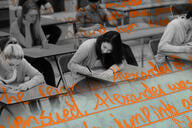You have /5 articles left.
Sign up for a free account or log in.
The traditional model: Students complete English as a Second Language (ESL) coursework as needed before enrolling in credit-bearing classes. Tuesday at New Jersey’s Fairleigh Dickinson University: 24 Korean-speaking degree-seekers began a new, three-year associate in arts degree program in which they simultaneously enroll in ESL and credit-bearing courses -- the latter taught largely in Korean the first year, equally in English and Korean the second, and only in English the third.
“In talking to individuals who would like to pursue a degree, they felt it was almost a barrier to have to take all the ESL before they could actually see progress toward a degree,” said Kenneth T. Vehrkens, dean of the Petrocelli College of Continuing Studies at Fairleigh Dickinson. “That’s where we came up with the idea for a parallel model."
Adult Korean speakers who enroll in the 61-credit “MiraeRo,” or "To the Future,” program will complete their class work in a cohort, taking two three-credit courses and nine hours of ESL at a time. The liberal arts program emphasizes business and courses include Introduction to Computers, Business in a Global Society, Mathematics, and Geography and World Politics. Students on F-1 visas are eligible (however, among the 24 students signed up so far, only one is an international student). The full estimated program cost for three years is $24,700, plus technology fees. The university plans to offer courses taught by full-time and part-time faculty, in addition to recruiting adjuncts from the Korean professional community.
MiraeRo is modeled on a very similar program for Spanish-speakers -- Puerta al Futuro -- that Fairleigh Dickinson introduced in fall 2003. “We thought we’d have about 20 students in the pilot group four years ago. We had 60, and the program has grown and is [now] servicing about 200 students,” Vehrkens said of the Puerta program. Of students in the first two cohorts, he said about 90 percent completed the associate degree.
“It’s been a very positive experience,” Vehrkens said. “This is really part of a long-range plan to provide access and opportunities for these various groups.”
“It’s a good idea,” said Joy Peyton, vice president of the Center for Applied Linguistics in Washington. A lot of her research has focused on ESL and native language education among adult learners.
While Peyton said she doesn’t know the details of the Fairleigh Dickinson program -- “Sometimes these things sound like a good idea in theory, but if you don’t have the appropriate materials and teachers it turns out not to be a good idea” -- she said that, if implemented correctly, such a "transitional bilingual" program would be very beneficial. (She would ideally like to see the university maintain the dual emphasis on the native language and English throughout the entire program, rather than transition entirely into English, she said.)
“When you’re at the university level, you need to learn a lot of content and you don’t have a lot of time," Peyton said. "You have limited time, you [a student speaking another language] need to learn the same amount of content every other student does, so why waste the time trying to get to a certain proficiency level in English before you start studying certain content?”




